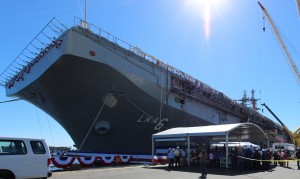Just when the large deck carrier demand goes up, but the supply goes down, adding the USS America to the fleet provides a long-term solution set. The expanding capabilities of the Gator navy come as change occurs in other parts of the USN fleet. And in the time it takes to build 1 large deck carrier, you can build 3 USS America’s.
A large part of the difference in build times is routed in that you can build a much greater proportion of the America in factories and on land before you have to put it into the dry dock. This means a faster build time when the ship is being finished.
A much higher degree of factory build means that the capability of the shipyard to build more Americas is also rooted in the manufacturing process.

Also, there is greater synergy between the America class and large deck carriers than with historical large deck amphibs. The America class has more aviation punch than the historical large deck amphibs.
And the synergy between the new large deck carrier (the USS Ford) and the America is significant.
As one of the America class ship designers put it: “We are talking regularly with the Ford design and build team about the work flow of F-35s and Osprey’s coming aboard the America.”
The challenge facing the USN was described as follows in a recent Inside the Navy article:
As the Enterprise (CVN-65) transits the Mediterranean Sea for the last time on its way home to Virginia for retirement and inactivation, the Navy is bracing for a new reality — starting Dec. 1, it will have only 10 aircraft carriers.
The key to maintaining an effective and responsive Navy is being able to both project power through regularly scheduled rotations and add surge forces when needed, Navy spokesman Lt. Cdr. John Fage told Inside the Navy on Oct. 16. But with just 10 ships in the fleet until the Gerald R. Ford (CVN-78) delivers in 2015, Program Executive Officer for Aircraft Carriers Rear Adm. Thomas Moore told ITN in an August interview that surging becomes much more complicated and risks long-term damage to the fleet.
“The demand signal is not likely to go down any time soon, and so we’r working pretty hard within in the maintenance community, and [Vice] Adm [Kevin] McCoy and his whole team at [Naval Sea Systems Command] and the shipyards, are looking real hard at what we can do to make sure we hand these ships back over to the combatant commanders and the operators ready to go,” Moore said. “And so we’ve been very successful with that, but we’ve been very honest with them about what we can and can’t do. And to be honest with you, more of it at this point is, the combatant commanders say ‘I want X number of carriers’ and we say ‘I can give you Y.'”
Excerpted from Inside the Navy, 10/29/2012,
When Enterprise inactivates . .

